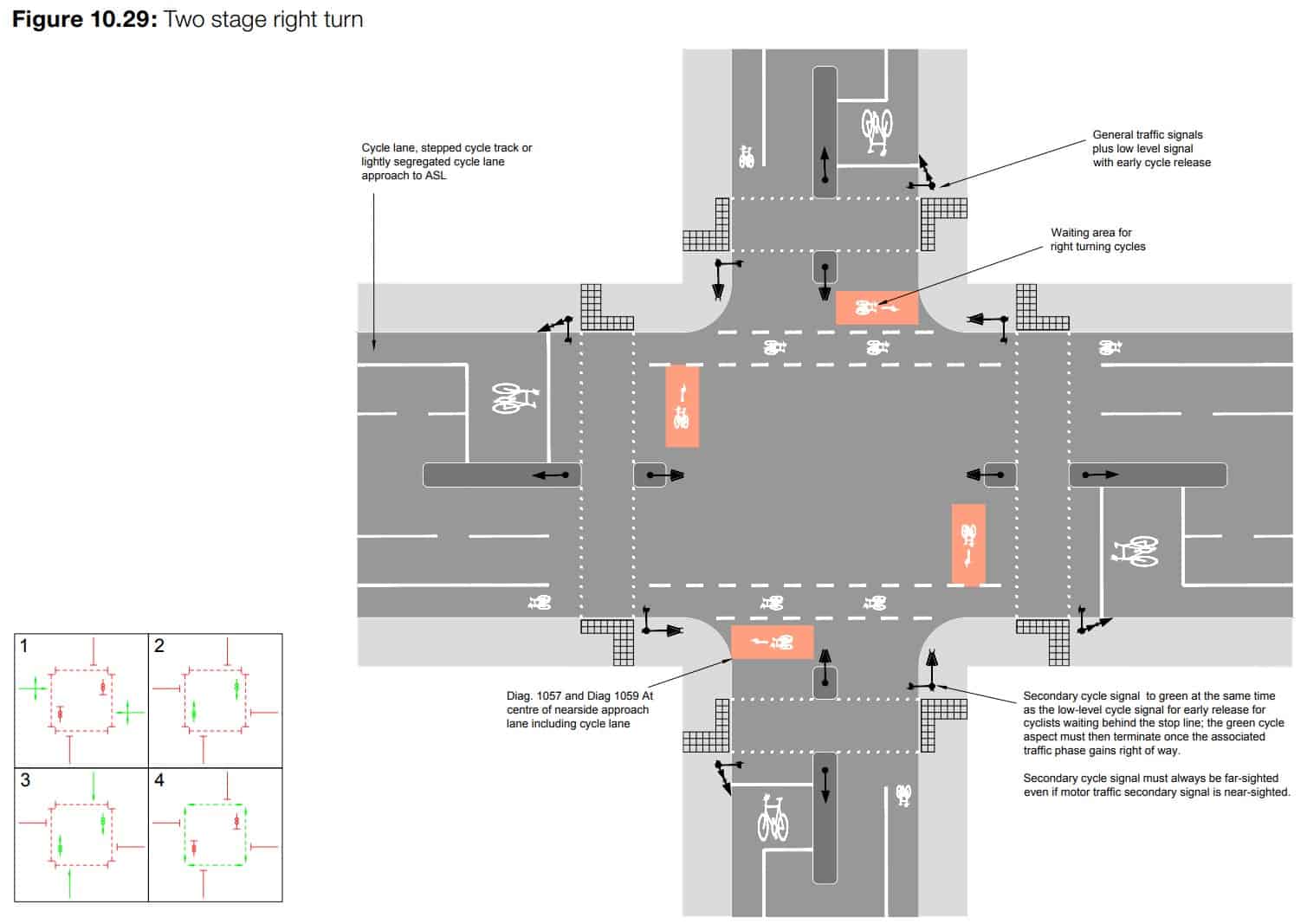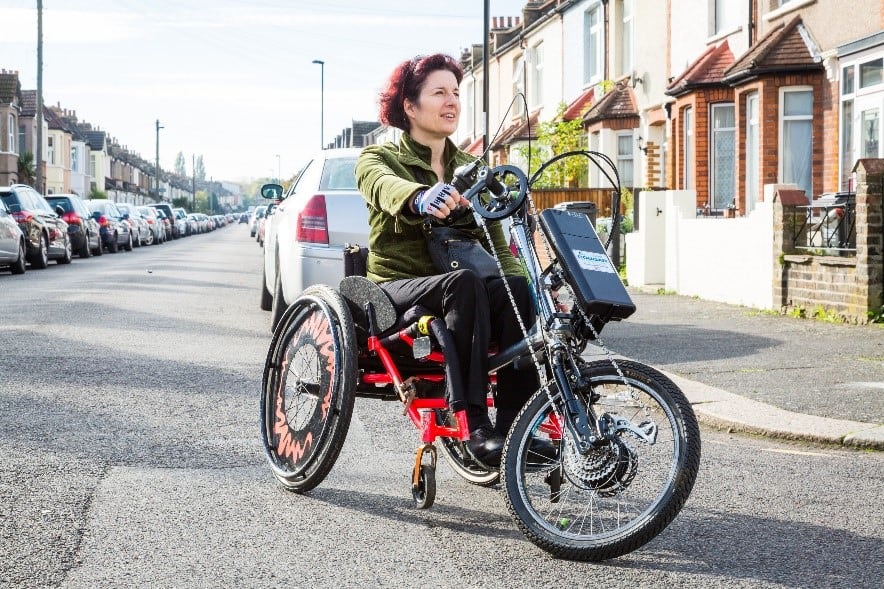Download this guide as a Word document
1 What are two-stage turns?

Highway Code rule 75 – Two Stage Turns
“At some signal-controlled junctions there may be signs and markings informing cyclists to turn right in two stages:
Stage 1: When the traffic lights turn green, cyclists wishing to make the turn should go straight ahead to the location marked by a cycle symbol and turn arrow on the carriageway; then stop and wait there
Stage 2: When the traffic lights on the far side of the junction, now facing the cyclists, turn green, they should then complete the manoeuvre”
Two-stage right turns are detailed in LTN 1/20 s10.6.28-33 and fig 10.29.
1.1.1 LTN 1/20 Cycle Infrastructure Design figure 10.29 Two-stage right turn

2 Summary
We believe two-stage turns are inaccessible and unsafe for most Disabled cyclists, and for many others with protected characteristics. They also expose all cyclists to risk in the second stage waiting location.
Two-stage turns and unprotected right turns should never be the only legal ways cyclists can turn where traffic volumes on any approach road to a junction are above 2000pcu/24hr (see LTN 1/20 fig 4.1).
Two-stage right turns are supposed to reduce the high risk that cyclists experience at standard right turns by removing the need to wait in the middle of junctions, without significantly affecting waiting times for drivers. Two-stage left turns are sometimes installed where a two-way cycle track enters a junction, to reduce delay to drivers.
The Equality Act (2010) requires that reasonable adjustments are made so that Disabled people can access society, including public spaces, in as close as possible the same way to non-disabled people. The Public Sector Equality Duty requires authorities to have due regard to the need to advance equality of opportunity for people with protected characteristics and promote participation in public life.
We have been unable to find any research into the accessibility of different cycle junction treatments for people with protected characteristics, including Disabled people.
3 Accessibility and safety problems with two-stage turns
3.1 Insufficient space for people using larger cycle types and people in accompanied groups
“Designers should ensure that the space provided for cycling at junctions is sufficient to accommodate the cycle design vehicle so that all types of user can negotiate the junction.” LTN 1/20 10.3.10
The Cycle Design Vehicle is 2.8m long and 1.2m wide, requiring minimum width 1.5m and minimum length 3.0m waiting space. It has a turning circle of minimum external radius 4m in motion (LTN 1/20 table 5-7) (a slightly smaller turning radius is given for low-speed “parking” manoeuvres, LTN 1/20 table 5-1. This table is not relevant to manoeuvres on cycle routes).
People using larger cycles will need the back of their cycle well clear of any moving vehicles. Designers need to remember that people cycling through junctions will not know the traffic signal phases. This means cyclists waiting in the second stage area will often behave as though the carriageway directly behind them will have vehicles moving along it, even if the phases of the lights mean it shouldn’t.
Many two-stage turns measured (using Google maps aerial images) provide 3-5m total waiting length. It is unfeasible on most junctions to provide more length, as the waiting space is dictated by the width of the carriageway.
This is insufficient room, especially for people using larger cycle types and travelling in accompanied groups, who will disproportionately be people with protected characteristics, including Disabled people. Remember that child trailers, rear toddler and child seats (including on tandems and triplets) all go at the back of cycles and all need to be at a safe distance from drivers. The Highway Code recommends drivers leave at least 1.5m clear space when passing cyclists.
The turning manoeuvres required by two-stage turns add additional problems to this lack of space.
3.2 Require people to start cycling rapidly while turning sharply
Two-stage turns require cyclists to start while making a sharp right (or occasionally left) turn, with limited time to make the manoeuvre after a far-side light turns green (this light may be either a main carriageway green light or a cycle early release light).
Disabled people and people using handcycles or heavier non-standard cycle types often need to start moving in a straight line (not while turning), and are likely to start slowly even with e-assist and on level ground.
The manoeuvres two-stage turns require will not be possible for many Disabled cyclists, which will prevent many from using the route which the junction is on.
Others will be unable to make the manoeuvre as quickly as the junction design intends, leaving them at risk of experiencing hostility and aggression or even of physical collisions from other cyclists and from drivers if they attempt to use the two-stage turn facility.
3.2.1 How handcycles move:

Handcycles have turning and pedalling (and usually brakes and gears) all controlled on the hand cranks. Leaning to turn isn’t possible on trikes: Just like on a foot pedalled tricycle, turning requires the rider to move their “handlebars” so one hand is in front of the other. For handcyclists, this moves their cranks into a position where it’s difficult or impossible to pedal. Handcyclists generally need to stop pedalling and glide around corners – so handcyclists need to start moving in a straight line before they can turn.
3.3 Hard to understand and interpret
“Cycle infrastructure should be accessible to everyone from 8 to 80 and beyond: it should be planned and designed for everyone. The opportunity to cycle in our towns and cities should be universal.” LTN 1/20 summary principle 1
Junctions are disproportionately dangerous locations for people cycling.
Paint markings and signage for two-stage junctions will be hard or impossible to see and interpret for many neurodivergent cyclists, cyclists with lower head heights (e.g. small people, people using recumbents), cyclists with visual impairments for everyone at busy times, at night and during bad weather. In addition, paint markings for these junctions are overrun by vehicles, so will be rapidly worn away.
Cycle infrastructure needs to be easy to understand, otherwise it will not be inclusive “for everyone from 8-80 and beyond” (LTN 1/20 1.6 summary principle 1). Two-stage junctions are complex and likely to be confusing and intimidating to many cyclists.
3.3.1 Where are you meant to wait?
The photos below provide the view from the first waiting area of a two-stage turn junction, from the height of an average standing adult. See if you can work out where you are supposed to wait for the second stage of the turn, and consider where that is relative to the location of the right-turn arm of the junction.

Here are the second stage waiting locations shown with white rings, and the junction right arms with white arrows:

In both these cases, the waiting area for the two-stage right turn is in a very counter-intuitive location relative to the right turn. At these junctions, the cyclist will need to turn their head beyond 90 degrees to the right in order to have a chance of seeing the second-stage signal change. It is not possible or is painful for many Disabled cyclists to hold their head turned to the side for prolonged periods, as the second stage of two-stage turns invariably requires. Some two-stage turns have less extreme layouts than these, but the head turning required is still very problematic.
3.4 “Fail-unsafe” design
Two-stage turns make cyclists stop and wait in a location which is only “safe” while the vehicle streams which will cross it are stationary. If anything goes wrong, the “safe” location will become a dangerous place to be: Unlike in most situations, where pulling into the kerb provides a relatively safe option for stopping at any time, there are no options for a Disabled cyclist to get into a safe space from the second stage waiting area of a two-stage junction if anything goes wrong.
The design of the second stage of two-stage turns relies on cyclists being able to see, identify and respond rapidly to a distant, small, green “cycle” signal, or to work out which of the visible main vehicle signals applies to them. It is not generally possible for a user to assess whether the second stage of the turn is going to be safe for them to use before they enter the junction space, which puts them at risk.
If the second stage far side signal isn’t working, or isn’t visible for any reason, such as large vehicles in the junction space, if a cyclist simply doesn’t see the signal change (perhaps they couldn’t hold their head in the turned position required for long enough), if there is a mechanical fault or error, or if the type of cycle or a physical or cognitive difficulty slows a cyclist’s start or if a cyclist misinterprets signals and moves off at the wrong time, the cyclist is at risk from drivers and other cyclists.
Designs which are at significant risk of failing in ways that leave users at risk are not suitable as part of an inclusive cycle network.
3.5 Other issues with two-stage turns:
- Require pedestrian crossings to be moved well off the desire line, to create space for the cyclist waiting area (two-stage right turns only).
- Create extra stop/start manoeuvres and delays for cyclists, requiring a stop even if they approach the junction on green – and even if drivers have a designated right turn lane and filter.
- Create additional hazards if there are left filter lanes (unless there is a “hold the left” signal provision).
- Cannot be used in combination with cycle/vehicle detection systems on side road signals – the cyclist waiting will not be in the right place to trigger the green signal phase they need.
- Potentially encourage cyclists to go through pedestrian crossings during the pedestrian green phase.
4 Our recommendations:
We would like to see high-quality research carried out to provide clear evidence on the accessibility of different junction designs.
In the meantime, we continue to recommend that cyclists need fully protected options to cross junctions. More accessible options can include Cyclops junctions, cycle green stages (not just advanced release for cycles, as these are also not inclusive), signalised separate cycle/pedestrian crossings and parallel crossings.
In very limited situations, where space means it is absolutely not possible to provide better options for cyclists and pedestrians even after vehicle space has been minimised, two-stage turns provided together with Toucan crossings which include “pedestrian priority, cycles slow” signage could provide a usable route across a junction which avoids severing routes for Disabled cyclists and others who are not able to use two-stage turns.
“A junction that does not provide safe facilities may prevent people from cycling through the junction, but may also be the reason that people will not use the remainder of a route.” (LTN 1/20 10.3.1)
